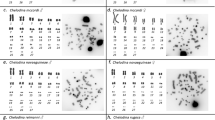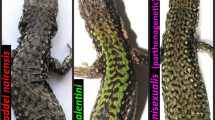Abstract
A NUMBER of instances of X and neo-Y mechanism of sex-determination is now on record in the Acrididæ1. The purpose of the present communication is to record a further case found in the grasshopper, Thisiocetrus pulcher of the subfamily Catantopinæ, collected in the area adjoining the Biology Departments of the University of Calcutta. Only two male individuals could be found, on two separate occasions, in spite of extensive search. The observations reported here, therefore, are from sectioned preparations of the testes of the first, and Feulgen squash preparations of the testes of the second, specimen. A large number of dividing cells was obtained in both of them, which enabled us to study the behaviour of the sex chromosome complex during spermatogenesis.
This is a preview of subscription content, access via your institution
Access options
Subscribe to this journal
Receive 51 print issues and online access
$199.00 per year
only $3.90 per issue
Buy this article
- Purchase on Springer Link
- Instant access to full article PDF
Prices may be subject to local taxes which are calculated during checkout
Similar content being viewed by others
References
King, R. L., J. Morph., 87, 227 (1950).
McClung, C. E., J. Morph., 29, 519 (1917).
Author information
Authors and Affiliations
Rights and permissions
About this article
Cite this article
RAY-CHAUDHURI, S., GUHA, A. X and neo-Y Mechanism of Sex-Determination in the Grasshopper, Thisiocetrus pulcher. Nature 169, 78–79 (1952). https://doi.org/10.1038/169078b0
Issue Date:
DOI: https://doi.org/10.1038/169078b0
This article is cited by
-
Somatic chromosomes of squirrel monkey (Saimiri sciureus)
Primates (1969)
-
Complex sex-determining mechanisms in three species of South American grasshoppers (Orthoptera, Acridoidea)
Chromosoma (1967)
-
Multiple Geschlechtschromosomen bei den cypriden Ostracoden, ihre Evolution und ihr Teilungsverhalten
Chromosoma (1957)
-
Supernumerary chromosomes in two populations of the grasshopper,Aiolopus sp. B, and their behaviour during spermatogenesis
Journal of Genetics (1955)
Comments
By submitting a comment you agree to abide by our Terms and Community Guidelines. If you find something abusive or that does not comply with our terms or guidelines please flag it as inappropriate.



